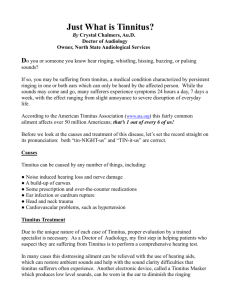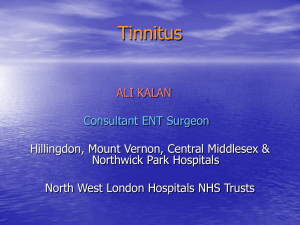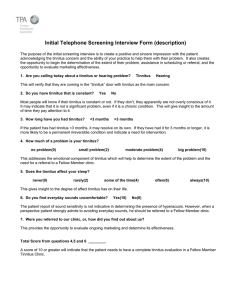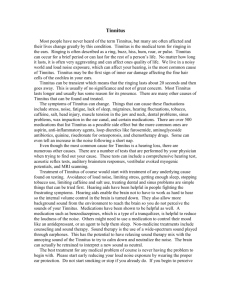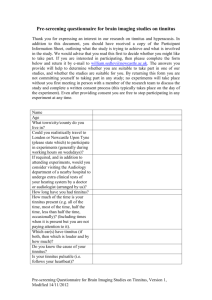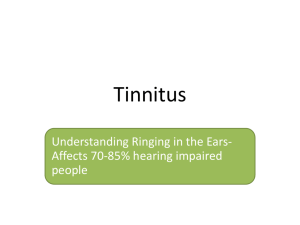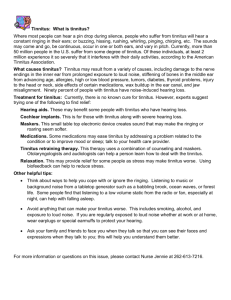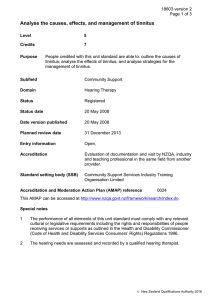Tinnitus Management in the Veterans Administration using
advertisement
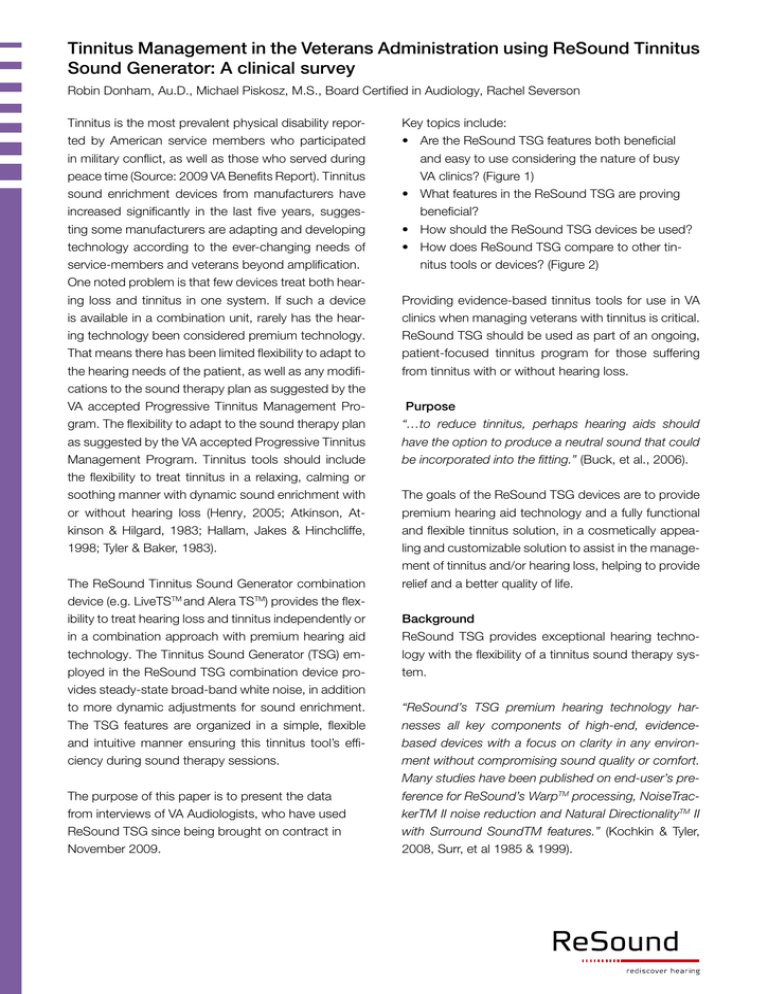
Tinnitus Management in the Veterans Administration using ReSound Tinnitus Sound Generator: A clinical survey Robin Donham, Au.D., Michael Piskosz, M.S., Board Certified in Audiology, Rachel Severson Tinnitus is the most prevalent physical disability reported by American service members who participated in military conflict, as well as those who served during peace time (Source: 2009 VA Benefits Report). Tinnitus sound enrichment devices from manufacturers have increased significantly in the last five years, suggesting some manufacturers are adapting and developing technology according to the ever-changing needs of service-members and veterans beyond amplification. One noted problem is that few devices treat both hearing loss and tinnitus in one system. If such a device is available in a combination unit, rarely has the hearing technology been considered premium technology. That means there has been limited flexibility to adapt to the hearing needs of the patient, as well as any modifications to the sound therapy plan as suggested by the VA accepted Progressive Tinnitus Management Program. The flexibility to adapt to the sound therapy plan as suggested by the VA accepted Progressive Tinnitus Management Program. Tinnitus tools should include the flexibility to treat tinnitus in a relaxing, calming or soothing manner with dynamic sound enrichment with or without hearing loss (Henry, 2005; Atkinson, Atkinson & Hilgard, 1983; Hallam, Jakes & Hinchcliffe, 1998; Tyler & Baker, 1983). The ReSound Tinnitus Sound Generator combination device (e.g. LiveTSTM and Alera TSTM) provides the flexibility to treat hearing loss and tinnitus independently or in a combination approach with premium hearing aid technology. The Tinnitus Sound Generator (TSG) employed in the ReSound TSG combination device provides steady-state broad-band white noise, in addition to more dynamic adjustments for sound enrichment. The TSG features are organized in a simple, flexible and intuitive manner ensuring this tinnitus tool’s efficiency during sound therapy sessions. The purpose of this paper is to present the data from interviews of VA Audiologists, who have used ReSound TSG since being brought on contract in November 2009. Key topics include: • Are the ReSound TSG features both beneficial and easy to use considering the nature of busy VA clinics? (Figure 1) • What features in the ReSound TSG are proving beneficial? • How should the ReSound TSG devices be used? • How does ReSound TSG compare to other tinnitus tools or devices? (Figure 2) Providing evidence-based tinnitus tools for use in VA clinics when managing veterans with tinnitus is critical. ReSound TSG should be used as part of an ongoing, patient-focused tinnitus program for those suffering from tinnitus with or without hearing loss. Purpose “…to reduce tinnitus, perhaps hearing aids should have the option to produce a neutral sound that could be incorporated into the fitting.” (Buck, et al., 2006). The goals of the ReSound TSG devices are to provide premium hearing aid technology and a fully functional and flexible tinnitus solution, in a cosmetically appealing and customizable solution to assist in the management of tinnitus and/or hearing loss, helping to provide relief and a better quality of life. Background ReSound TSG provides exceptional hearing technology with the flexibility of a tinnitus sound therapy system. “ReSound’s TSG premium hearing technology harnesses all key components of high-end, evidencebased devices with a focus on clarity in any environment without compromising sound quality or comfort. Many studies have been published on end-user’s preference for ReSound’s WarpTM processing, NoiseTrackerTM II noise reduction and Natural DirectionalityTM II with Surround SoundTM features.” (Kochkin & Tyler, 2008, Surr, et al 1985 & 1999). It should be noted that hearing aids alone have been used in tinnitus treatment programs with success (Surr et al., 1985; Surr et al., 1999; Sanchez & Stephens, 2000). Treatment of hearing loss and tinnitus using the ReSound TSG as a combination device can assist in reducing the perception of tinnitus by applying an adjustable white noise, which can help a person learn to ignore or habituate to the sound of their tinnitus. ReSound TSG is a hearing aid worn during the day that will also serve to improve communication, while providing sound therapy. The unique features incorporated into the ReSound tinnitus units are easy to activate, adjust and update according to patient’s preference and with the ability to stream wirelessly, ReSound presents an unlimited number of options to assist the patient’s ability to manage his/her tinnitus. ReSound TSG models incorporate an additional Tinnitus Sound Generator screen in the Aventa Software, where activation and adjustment of the white-noise generator occurs; this feature defaults to “off” until activated by the clinician. This enables the audiologist to determine when and how to use this type of sound enrichment. The sound generator in ReSound TSG relies on an earlevel white noise generator to help reduce the contrast of the tinnitus to the background environment, helping the brain to learn to habituate to the tinnitus or the patient learning to ignore the tinnitus. Research suggests that masker-only devices will not only be difficult to set in treating tinnitus depending on the degree or volume of the perceived tinnitus, but additionally the effectiveness of true maskers will decrease over time (Dineen, Doyle, Bench, et al, 1999, Erlandsson, Ringdahl, Hutchins & Carlsson, 1987; Hiller & Haerkotter, 2005; Jakes, Hallam, McKenna & Hinchcliffe, 1992). True Sound Therapy, especially when used as part of a Tinnitus Retraining Program (including a counseling component) has not only been proven successful, but some believe that this type of therapy eventually eliminates the need for a noise-generating device altogether (Jastreboff, Gray, Gold, 1996; Schleuning & Johnson, 1997). Even in the case of other more progressive tinnitus programs such as Progressive Tinnitus Management, the need to provide whatever sound “works” for the individual patient makes the adaptability of the device selected critical. Additionally, exclusive to ReSound, is the ReSound TSG Environmental SteeringTM feature, which will decrease the sound generator volume automatically when noise or speech is present, and return to the pre-set sound generator levels when the patient is in quiet or soft speech environments. With flexibility as the motivation behind ReSound’s TSG technology, the Tinnitus Sound Generator should be considered a viable option. Methods Sixty-one interviews were conducted with dispensing Audiologists in VA clinics. Audiologists were randomly selected from ReSound’s database with only one prerequisite: that he or she has ordered the ReSound TSG devices since November, 1, 2009. Survey sample was identified and evaluated by account managers and reported to be experienced with treating tinnitus and trained on appropriate use of the ReSound TSG device fitting guidelines. Data collection took place from September 1st through November 24th, 2010. Complete confidentiality was maintained by first confirming fitting audiologist according to serial numbers of ReSound TSG devices, then removing dispensing audiologist information from interview data and assigning data to a numerical region. Population fit with ReSound TSG devices by audiologists were veterans from any conflict with age ranging from 24 years to 88 years, predominately male. This follows typical VA trends. Interviews were conducted over the phone by inside account managers trained on ReSound TSG features. Questions were posed on a ten-point scale, however, optional comments following each question were encouraged by interviewer. If unlisted responses were provided by the responder, the category options were updated to ensure complete option list and exclude any biases on the part of the interviewee. Unlimited time was given for answering each question maximizing the validity and thoroughness of the responses. . Average score - Efficiency, Flexibility and Achieving Tinnitus Goals with ReSound TSG* 10 9 Ease of Use - ReSound TSG* 8 7 Ease of Use - Aventa 2.9 6 Flexibility; Meeting Patient Needs 5 4 Achieving Tinnitus Treatment Goals 3 Conclusion Evidence from the survey demonstrated the effectiveness of the ReSound TSG device in helping clinicians achieve their tinnitus treatment goals, and provides the flexibility to meet individual patient’s needs with a ‘significant or satisfactory’ improvement found in 83% of respondents who activated the Sound Generator in tinnitus fittings. (Figure 3) 2 1 Figure 1: Average scores of different measured parameters of ReSound TSG*. VA TS Survey ReSound TSG* compared to other Tinnitus products Much Better/Better 62% 32 responses Same 8% - 5 responses Hasn´t tried others 25% 15 responses Figure 2: ReSound TSG* compared to other tinnitus available tinnitus products. Improvement reported with ReSound TSG* used as a Tinnitus tool “Significant Improvement or Satisfactory Improvement.” 90 80 Significant improvement/ Satisfied w/ReSound TSG 83% 70 More tools needed for Tinnitus improvements 60 50 40 30 20 17% 10 0 Figure 3: Improvement reported using ReSound TSG*. Since 2007 tinnitus has increased more dramatically than hearing loss and is now the number one service connected disability in veterans. The research and statistics suggest that ReSound TSG is an efficient, effective, flexible and therefore viable option for use in VA clinics as a tinnitus tool. ReSound’s TSG is built with the flexibility and advanced technology to accomplish treating hearing loss and tinnitus in just one system, providing many conveniences. Capable tinnitus devices and tools are just one part of an effective, multidisciplinary approach to tinnitus management which should also include productive counseling support techniques and tinnitus education, such as Progressive Tinnitus Management, where a structured program using patient education, sound enrichment/ therapy and teaching coping techniques is used to manage reactions to tinnitus. With PTM the patient is encouraged to use whatever sound works to manage reactions to tinnitus and is part of the process to develop a “sound therapy toolbox,” which can continuously be updated through categories of sounds. Each sound enrichment plan is customized to address patient’s individual needs (Henry, et al., 2005). Utilization of complete evidence-based programs, such as PTM may even further improve the success of tinnitus tools such as ReSound TSG. According to this Sound Classification chart, ReSound TSG falls into at least two groups (Figure 4): 1. Soothing: Feel instantly better when this type of sound is heard 2. Background: Neutral sound; easy to ignore, but provides noise to defocus from tinnitus 3. Interesting: Completely controls or shifts auditory attention from tinnitus to sound The data suggest ReSound TSG can help provide significant improvement for veterans suffering from tinnitus. ReSound TSG offers the flexibility to address your patient’s needs, for both hearing loss and tinnitus treatment. Future studies need to incorporate the type of counseling or tinnitus management being performed in conjunction with the ReSound TSG tinnitus tool, to better understand the interaction between the two. Environmental Music Speech Soothing Rain Canon in D Kids playing Background White noise Highschool band Boring lecture Sports radio Interesting Football game Child´s first song Toddlers reason for not sleeping Figure 4: Classification of sounds using PTM. ReSound TSG* falls into two of these categories. *All results were collected using LiveTSTM 9 products and the Aventa 2.9 software. References Atkinson, R. L., Atkinson, R. C., Hilgard, E. R. (1983). Introduction to Psychology, 8th Edition, 640. New York, Harcourt, Brace, Jovanovich. Buck, T.F., George, K.L., Turner, J.G., Verlinden, N.H.P. (May 2006). Content Suggestions for Universally Designed Hearing Aids. Worcester Polytechnic Instituted 1865. Dineen, R., Doyle, J., Bench, J., Perry, A. (1999). The influence of training on tinnitus perception: an evaluation 12 months after tinnitus management training. British Journal of Audiology, 33, 29–51. Erlandsson, S., Ringdahl, A., Hutchins, T., Carlsson, S. G. (1987). Treatment of tinnitus: a controlled comparison of masking and placebo. British J of Aud, 21, 37–44. M200585-GB 11.04 Rev.A Hallam, R. S., Jakes, S. C., Hinchcliffe, R. (1988). Cognitive variables in tinnitus annoyance. British Jof Clinical Psychology, 27, 213–222. Henry, J. A., Schechter, M. A., Loovis, C., Zaugg, T., Kaelin, C., Montero, M. (2005). Clinical management of tinnitus using a ‘progressive intervention’ approach. Journal of Rehabilitation Research & Development, 42, 95–116. Henry, J. L., Wilson, P. H. 1999. Cognitive-behavioural therapy for tinnitus-related distress: an experimental evaluation of initial treatment and relapse prevention. In Hazell, J. W. P., (Ed). Proceedings of the Sixth International Tinnitus Seminar, 292–296. London, Tinnitus and Hyperacusis Centre. Hiller, W., Haerkotter, C. (2005). Does sound stimulation have additive effects on cognitive-behavioural treatment of chronic tinnitus? Behaviour Research and Therapy, 43, 595–612. Jakes, S. C., Hallam, R. S., McKenna, L., Hinchcliffe, R. (1992). Group cognitive therapy for medical patients: an application to tinnitus. Cognitive Therapy Research, 16, 67–82. Jastreboff PJ. Gray WC. Gold SL. (1996). Neurophysiological approach to tinnitus patients. Am J Otol 17(2):236-40. Kochkin & Tyler. (2008). Effectiveness of Hearing Aids in Mitigating Tinnitus in Typical Patients – Survey of 230 Hearing Portland, Oregon, American Tinnitus Association. Surr, R. K., Montgomery, A. A., Mueller, H. G. (1999). Effect of amplification on tinnitus among new hearing aid users. Journal of the American Academy of Audiology, 10, 489–495. Schleuning AJ. Johnson RM. Use of masking for tinnitus. Int Tinnitus J 1997: 3(l):25-9. Tyler, R. S., Baker L. J. (1983). Difficulties experienced by tinnitus sufferers. Journal of Speech and Hearing Disorders, 48, 150–154. VABenefitisSource: http://www.vba.va.gov/REPORTS/abr/2009_abr.pdf
